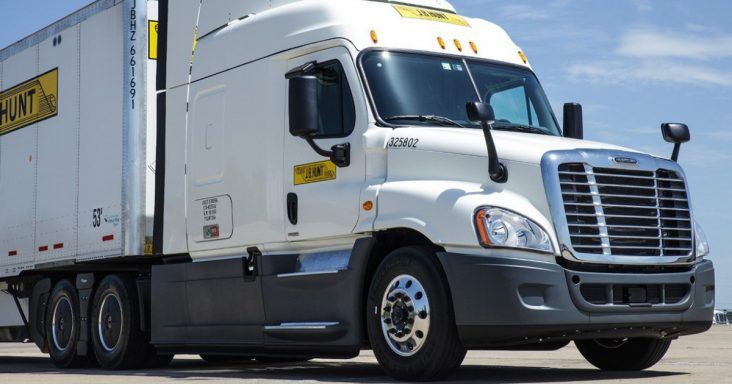Logistics outsourcing trend to benefit J.B. Hunt, spot rates up 20%
by November 27, 2017 1:33 pm 684 views

As demand for spot truckload freight and spot rates accelerate, shippers have increased the amount of transportation and logistics services they outsource to third-party logistics (3PL) providers.
In a recent conference call on the 2018 Annual 3PL Study, it showed 83% of shippers outsource at least one aspect of their U.S. transportation needs to 3PL companies. John Larkin, trucking/transportation analyst for Stifel, hosted the call on the 22nd annual study, which was produced as a result of an email survey sent to more than 10,000 shippers and 3PL providers. The study was developed by Penn State’s Smeal College of Business, Infosys Consulting, Penske and Korn Ferry.
The gap between how satisfied shippers and 3PL companies are with a 3PL’s technology rose in 2017 as shippers expected “more predictive big data analytics that can drive more proactive decision making,” according to Larkin. “3PL’s have been a little slow to respond to this new customer desire.”
Shippers and 3PL companies have started to look at blockchain as a way to accelerate transactions, reduce errors and increase security. The digital ledger known as blockchain creates a step-by-step log of a shipment within the supply chain. As various transactions take place, blocks of information are added to the chain, said Shanton Wilcox of Infosys.
Some of the key areas in which shippers are interested in blockchain include load tracking, visibility in the supply chain and compliance with regulations. 3PL providers are also interested in the previous but also as a way to ensure the security of high risk shipments and to monitor them throughout the supply chain, according to Larkin. However, two-thirds of 3PL providers and 75% of shippers were unsure what to expect from blockchain and were skeptical it would improve security.
Throughout the supply chain, the development of automation and digitization is increasing rapidly and includes autonomous vehicles, the internet of things (IoT), digitization of load boards and brokerage operations, and warehouse robots. This will “enable scarce workers to focus on higher level functions and experience some meaningful level of job enrichment,” Larkin noted. However, about two-thirds of shippers and 3PL providers are investing less than 5% of capital expenditures on automation and digitization as “few are confident in potential returns on investment.”
Yet, many companies look at automation and digitation “as ways to set themselves apart,” said Melissa Hadhazy of Infosys.
As the industry moves toward more automation and digitization, it will require a “new breed of supply chain and logistics leaders,” according to Neil Collins of Korn Ferry. “Organizations are aware of the talent they need.”
These leaders include those who are partner/collaborators, who are agile and can adapt to quickly changing technology, Collins said. They function with less structure, less bureaucracy and handle more project work. “More strategic thinking with tactical thinking is coming to the fore.” The topic of talent is becoming “much more sophisticated,” and he expects it will continue to “get more complex.”
Hadhazy said work has already started on the 2019 study, and some of the issues include the expansion third-party logistics in China, the role of the supply chain and humanitarian efforts and regulatory issues.
Lowell-based carrier J.B. Hunt Transport Services was one of the companies Larkin sees that will benefit as the trend toward logistics outsourcing accelerates. Stifel, which gives J.B. Hunt a buy rating, also sees XPO Logistics, Echo Global Logistics, Universal Logistics Holdings and C.H. Robinson Worldwide as beneficiaries of the trend. “Shippers are increasing fearful of falling behind in the supply chain race and increasingly are turning to outside vendors to access more process knowledge, better technology and economics of purchasing scale,” Larkin noted. http://www.jbhunt.com/
Meanwhile, spot freight demand and pricing have risen in November after moderating in October following “robust September levels,” according to Benjamin Hartford, senior research analyst for Baird. Dry-van spot rates have risen between 15% and 20%, from the same month a year ago. “All-in, trends continue to support accelerating core contractual truckload pricing growth into 2018.”
At the same time, U.S. intermodal pricing is expected to accelerate but will lag behind truckload price increases. Intermodal pricing typically lags behind truckload by between two and four quarters, according to Hartford. For the week ending Nov. 18, U.S. intermodal volume rose 3.9% to 287,139 containers and trailers, according to the Association of American Railroads.
